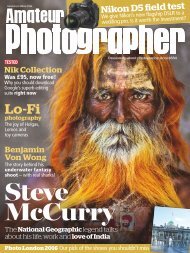You also want an ePaper? Increase the reach of your titles
YUMPU automatically turns print PDFs into web optimized ePapers that Google loves.
not convince Fred or others of the radial<br />
features’ reality. Instead, I was met with a<br />
seemingly unified resistance.<br />
As James Bryant of McDonald<br />
Observatory would later write in the 2007<br />
Journal of Astronomical History and<br />
Heritage, “[While his] audience knew him<br />
to be honest, competent, free of agenda …<br />
his evidence was very difficult to accept<br />
because it ran contrary to physics. …<br />
Inaction that followed O’Meara’s report<br />
of spokes in 1976 may have been caused<br />
by others’ distrust of the visual method<br />
he used.”<br />
Going it alone<br />
While I understood the reasoning behind<br />
others’ disbelief, further observations of<br />
the features convinced me they were real.<br />
I could not dismiss them as an atmospheric<br />
phenomenon or telescopic illusion.<br />
Over the next four years, I conducted a<br />
systematic observing campaign of the B<br />
ring. I submitted the results to journals for<br />
publication without success. For instance,<br />
in 43 days (January 24 to March 8, 1977),<br />
I observed 29 radial features (or radial<br />
complexes) when Saturn’s rings were tilted<br />
around 17° to our line of sight.<br />
The more I observed them, the more<br />
dissimilar they became to ring A’s azimuthal<br />
variations. On some evenings, I<br />
would monitor the radial shadings for<br />
hours, watching the motion of individual<br />
streaks, which not only rotated in the same<br />
direction as the planet’s cloud tops but also<br />
at a similar rate. I also followed the radial<br />
features through changing ring-angle<br />
phases (from about 17° in 1976 to nearly<br />
edge-on in 1980). During that time, I created<br />
graphs that showed how the prominence<br />
and number of these radial features<br />
diminished dramatically as the rings’<br />
angle decreased.<br />
My systematic observations ended in<br />
1980 when Saturn and its near edge-on<br />
rings went into conjunction with the Sun<br />
— also just before Voyager 2 arrived at<br />
Saturn and obtained credit for the discovery<br />
of Saturn’s radial “spokes” … but not<br />
before I had one last chance to be heard.<br />
Prior to Voyager 2’s arrival at Saturn, I<br />
showed a sample of my Saturn drawings to<br />
Sky & Telescope’s J. Kelly Beatty, who was<br />
leaving for the Jet Propulsion Laboratory<br />
to cover the event. Kelly first showed me<br />
the latest images from the spacecraft, then<br />
I handed him some of my drawings, saying,<br />
“Please call me when Voyager images<br />
these features in ring B,” and pointed out<br />
the radial shadings. Kelly chuckled and<br />
For years, the<br />
author used<br />
Harvard College<br />
Observatory’s<br />
9-inch Alvan Clark<br />
refractor to observe<br />
Saturn. COURTESY STEPHEN<br />
JAMES O’MEARA<br />
said, “Right.”<br />
About a week<br />
later, Kelly saw<br />
the Voyager 2<br />
images of the<br />
spokes appear on<br />
a large screen at<br />
the JPL pressroom.<br />
He said he fell back in his chair,<br />
exclaiming that I had seen the spokes four<br />
years ago. As Mark Washburn records in<br />
Distant Encounters, “The news traveled<br />
quickly, and an hour later [Voyager imaging<br />
team leader] Brad Smith appeared in<br />
the pressroom, asking Beatty, ‘What’s this I<br />
hear about someone seeing spokes?’ ” Like<br />
others, Smith was unconvinced.<br />
Regardless, Kelly did call, and I was<br />
astounded by the news.<br />
Riddle me this<br />
Now that spacecraft have imaged the<br />
spokes, scientists are trying to solve the riddle<br />
of their existence. One theory is that the<br />
ring’s icy dust particles get an electrostatic<br />
charge when they move out of Saturn’s<br />
shadow and into sunlight. (It’s the same<br />
type of electrostatic discharge that causes<br />
static cling when you pull clothes from a<br />
dryer.) The charge levitates the particles<br />
above the ring plane and into Saturn’s magnetic<br />
field, which co-rotates with the planet.<br />
One mystery, however, is that the spokes<br />
can disappear for long periods of time. For<br />
instance, they remained elusive from 1998<br />
to 2005 — even to the Cassini spacecraft<br />
when it arrived in 2004. Cassini did begin<br />
to detect them in 2005, albeit weakly. That<br />
prompted scientists to speculate that spokes<br />
may appear mainly during certain seasons<br />
of the long saturnian year, perhaps in<br />
response to the changing angle at which<br />
sunlight hits the rings. If so, spokes may<br />
have seasons, and may not form at times<br />
when the Sun is between 17° and 24° above<br />
the ring plane. (Interestingly, my pre-Voyager<br />
observations took place when the Sun<br />
was between 16.5° and 3° above the ring<br />
plane, during a theoretical time of maximum<br />
spoke production.)<br />
Other plausible explanations include<br />
asteroids plowing into the rings and whipping<br />
up a cloud of plasma (which then levitates<br />
above the ring plane because of the<br />
magnetic field), and powerful lightning<br />
strokes that surge up from Saturn’s clouds,<br />
wallop the rings, and blast out jets of electrically<br />
charged dust as spokes. This latter theory<br />
holds promise, as spacecraft data also<br />
suggest that spokes happen with about the<br />
same frequency as the planet’s thunderstorms.<br />
Its magnetic field could transport<br />
electron beams from above these storms into<br />
the rings, where they charge the dust.<br />
Whatever the radial features are in<br />
the B ring, they have now succumbed to<br />
a flurry of new amateur sightings and CCD<br />
images — some with telescopes a lot more<br />
modest than the Harvard 9-inch refractor.<br />
When truth shocks us into believing,<br />
the fog of uncertainty lifts, allowing us to<br />
see more clearly with new eyes.<br />
WWW.ASTRONOMY.COM 53






